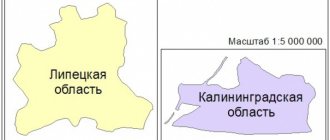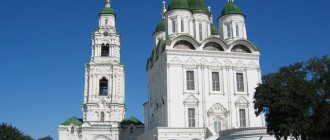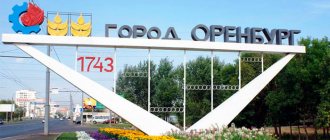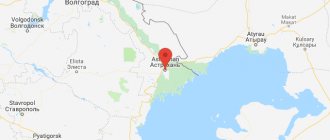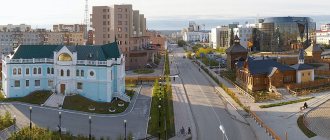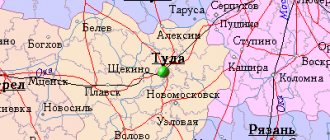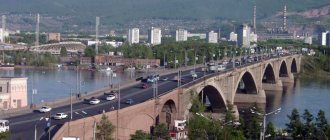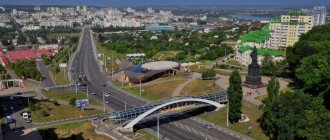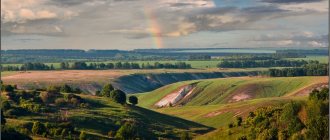Year of foundation: 1593
City Day is celebrated
on August 5th
.
In 2021, due to the pandemic, mass events in honor of the city day are canceled or may be postponed
Belgorod station
Belgorod
- a Russian city, the center of the Belgorod region, located on the Seversky Donets River.
It is believed that the Slavic city of Belgorod was founded in the 10th century
.
However, it was later destroyed and the lands remained empty for a long time. Tsar Fyodor Ioannovich revives the city again, founding a border fortress in 1593
. In 1622, during an attack by Polish-Lithuanian troops, the fortress was burned. After this, Belgorod was built on the left, eastern bank of the Seversky Donets - now the Old Town is located there.
The Belgorod fortress was built in 1650 on the right bank of the Seversky Donets at the confluence of the Vezelitsa River. Since 1658, Belgorod was the main city of the Belgorod Line - a defensive line that protected the Muscovite kingdom.
In 1712, by decree of Peter I, the banner of the Belgorod Infantry Regiment, which especially distinguished itself in the Battle of Poltava, was introduced. The banner depicts an eagle, the symbol of Russia, soaring above a running lion, the symbol of Sweden. It is this symbolism that is the basis of today’s coat of arms and flag of the city.
During the Great Patriotic War, Belgorod was twice occupied by German troops and liberated from the Nazi invaders after the battles on the Kursk Bulge.
House of the merchant Selivanov In 1954, the Belgorod region was formed. In 1980, the city was awarded the Order of the Patriotic War, 1st degree, for the courage and fortitude shown during the Great Patriotic War and for the successes achieved in economic and cultural construction.
Now the city is actively developing and has a positive population growth. Belgorod has repeatedly taken the honorable first place in terms of cleanliness and livability among Russian cities. In 2007, by decree of the President of the Russian Federation, Belgorod was awarded the title “City of Military Glory”.
This oak tree dates back to the fifth century
It is interesting to visit
in Belgorod the diorama of the Battle of Kursk, the military-historical museum-reserve “Prokhorovskoe Field”, the Transfiguration Cathedral, the Assumption-Nicholas Cathedral, the Smolensk Cathedral, the house of the merchant Selivanov. Around the city there are many ancient estates with their unique atmosphere.
A unique oak grows in the Belgorod region; its crown occupies 25 acres. The tree is over 400 years old. This tree is one of three that are protected by the state as a natural monument in Russia.
The city has a population of about 392 thousand people (2018).
Day of the city
celebrated on August 5 in memory of the liberation of the city from the Nazi invaders in 1943. It was this day that became the day of the first fireworks display in the Great Patriotic War. Fireworks were fired in two liberated cities - Belgorod and Orel.
Belgorod
Video: Winter Belgorod from above
Basic moments
Nowadays, Belgorod is a large city with a well-developed infrastructure, which is a scientific, economic, cultural and at the same time spiritual center.
The city attracts tourists with its magnificent architecture, numerous streets (there are 576 of them in the city!), picturesque boulevards and avenues, the total length of which is as much as 460 km. In addition, Belgorod is a major transport hub of the country.
It should be noted that Belgorod is the winner of awards for the livability of the city.
You should come to Belgorod to visit the city’s museums – the Art and Literary Museums, and also visit the Academic Theater. Shchepkin, view the diorama “Battle of Kursk” and visit numerous cathedrals in Belgorod.
Tourists can stay in one of the comfortable hotels in Belgorod and have a meal in the city's upscale restaurants.
Climate
The climate of Belgorod belongs to the temperate continental type. In summer the city is dry and hot, and in winter it is quite cool.
Attractions
Belgorod's attractions include numerous museums, theaters and architectural attractions.
For example, you should see the House of Merchant Selivavnov, which houses the Literary Museum, and the mansion of the merchant Goltsov, dating back to the 19th century. The buildings of the Women's Gymnasium on Narodny Boulevard and the residential building on Slavy Avenue are interesting from an architectural point of view. In addition, do not ignore the Volkova estate.
Other interesting places in Belgorod are religious: this is the Transfiguration Cathedral, which is the main temple of the Belgorod-Starooskol diocese, the ancient Smolensk Cathedral, the Assumption-Nicholas Cathedral and others.
In addition, the attractions of Belgorod include the diorama “Battle of Kursk”, as well as the Museum of Local Lore.
Excursions
Excursions in Belgorod are a unique opportunity to get to know the city and its surroundings better.
Thus, the most popular is the sightseeing tour “Belgorod in the Past and Present”. During the sightseeing tour, tourists can view the “Battle of Kursk” diorama, visit the Literary Museum, the Museum of Folk Culture, the Museum of Communications and see other sights of Belgorod.
The following excursions in Belgorod are also interesting: “Holy Belogorye” - a tour of the religious places of the city, an excursion to the Shchepkin Museum, an excursion to the village of Prokhorovka and a visit to the military history museum, a visit to the village of Kupino and the museum “Peasant Compound” and many other excursions of Belgorod.
Story
The history of Belgorod began as the history of a fortress that defended the southern borders of Rus' from the devastating raids of the Tatars from the Crimea. It is believed that the city was founded in 1593, but the first mentions of it date back to an earlier time.
During the Time of Troubles, the history of Belgorod was connected with the Polish-Lithuanian invasions, which destroyed the city to the ground. In general, it is interesting that during the entire period of its existence the city changed its location not once, but three times!
In the 17th century, the history of Belgorod was again turbulent - in total, over 100 years, the city was raided more than 10 times.
The population consisted of Russian peasants, as well as immigrants from Poland and Lithuania. Thus, the history of Belgorod was closely connected with neighboring states.
Until the 18th century, Belgorod was an important strategic point.
Since the 18th century, Belgorod became a district city of the Kursk province.
In peacetime, crafts actively developed in Belgorod, the city conducted active trade, and developed its economy. In particular, the city is famous for its shoemakers, blacksmiths, sheepskin makers, and tanners.
In 1869, the history of Belgorod made a sharp turn: the Kursk-Kharkov-Azov railway was built here. This influenced the growth of the population of Belgorod; industrial enterprises and educational institutions opened in the city.
By the beginning of the 20th century, Belgorod was already a rich county town.
Accommodation
Hotels in Belgorod are modern and comfortable hotels located both in the city itself and on its outskirts.
Note that a night in a Belgorod hotel will cost a tourist from 800 rubles.
The city has both state hotels and private hotels.
Among the best hotels in Belgorod are “Mir” (from 2 thousand rubles), “Milan” (from 2,800 rubles), “Belogorye” (from 3,500 rubles).
More budget options are the Polar Star hotel (1,700 rubles), Success (1,000 rubles).
Sports and active recreation
Active recreation in Belgorod is very popular and very well developed.
So, in the Virazh sports complex you can go karting. The cost of 10 minutes of pleasure is from 2540 rubles.
Paintball is also popular in Belgorod - there are 5 paintball clubs in the city.
Other active recreation activities in the city include roller skating and skiing, parachute jumping at the aviation sports club, and aeronautics.
Transport
Transport in Belgorod is mainly represented by buses and trolleybuses that run throughout the city. The total length of trolleybus routes is over 120 km.
In addition, the city has 2 bus stations, from where you can easily reach the suburbs by bus.
You can call a taxi in Belgorod from any hotel.
Souvenirs
Souvenirs of Belgorod are traditional souvenirs such as key rings, badges and refrigerator magnets with views of the city. Other interesting souvenirs are products of local craftsmen, ceramic products - cups, bells, as well as woven products. Don’t forget to take photographs - they can also become a memorable souvenir, reminiscent of your trip to Belgorod.
How to get there
There are several ways to get to Belgorod. For example, on an airplane. The city has an international class airport "Belgorod".
You can also get to the city by rail - the Belgorod railway station operates here. Travel time from Moscow to Belgorod by train is just over 9 hours.
You can also get to the city by bus: the travel time from Moscow to Belgorod by bus is 8 hours, the cost of tickets in 2013 is 900 rubles.
History of conferring the honorary title “City of Military Glory”
During the Great Patriotic War, Belgorod was occupied twice by the Nazi invaders: October 24, 1941 and March 18, 1943.
The first liberation was carried out during the Kharkov offensive operation on February 9, 1943, the second liberation of Belgorod occurred during the Battle of Kursk on August 5, 1943. During the second liberation the city was heavily destroyed. In honor of the liberation of Belgorod and Orel, Moscow saluted the Soviet troops for the first time with 12 artillery salvoes from 120 guns.
By a decree of the Presidium of the Supreme Soviet of the USSR dated April 9, 1980, Belgorod was awarded the Order of the Patriotic War, 1st degree, for the courage and fortitude shown by the working people of the city during the Great Patriotic War, and for the successes achieved in economic and cultural construction.
Theaters
Theaters can be chosen to suit every taste. Children can be taken to a puppet theater or children's musical theater. The pride of the latter is the high-quality stage design, and each performance is accompanied by “live” music from a real orchestra, which significantly makes any performance bright and expressive.
Children's musical theater, Pervomaiskaya street, building 2A
There is also a fashion theater “Panther” in the city. Its catwalk hosts demonstrations of branded clothing performed by professional models. In addition, dance shows are organized here accompanied by performances by vocal performers. The Philharmonic, which includes: a symphony, jazz and orchestra of Russian folk instruments, can pleasantly surprise you with its musical art; chamber choir, vocal and choreographic ensemble "Belogorye".
Belgorod State Philharmonic, Belgorod Regiment Street, 56A
You can go to the Drama Theater, which is named after a fellow countryman - Mikhail Semenovich Shchepkin. He was a great Russian actor, one of the founders of the national acting school.
Right there on the square, next to the theater, you can walk along the pedestrian zone, the so-called Walk of Labor Glory. It was opened in 2002 and is still replenished every year with new names of Belgorod residents who have achieved success and earned honor and glory in various sectors: agriculture, energy, housing and communal services, law enforcement agencies, healthcare institutions, pensions, science and education and many others.
Victory and Lenin parks are located nearby. The first of them is located on the picturesque banks of the Vezelka River and is a favorite walking place for residents and tourists. It gets especially crowded here in the evenings. The decoration of the park is a light and music fountain, in which there is a sculpture of a lion (the symbol of Belgorod). In summer, there is a boat rental shop near the river. With children you can feed the ducks or visit the children's playground.
Vezelka River, Victory Park. Belgorod.
And the main attributes of the park are numerous sculptures dedicated to the memory of the victory in the Second World War: the Alley of Heroes, the monument to Marshal Zhukov, the monument to the liberators.
Fountain "Invincible", Victory Park. Belgorod.
In this place you can educate younger generations about the great feat of their near ancestors. In the park named after V.I. Lenin has a lot of all sorts of attractions - these are various carousels (from small to large), trains, trampolines, an autodrome and electric cars, a shooting gallery, a Ferris wheel and much more. The park has been modernized according to the latest foreign project, combining both wide scope and functionality.
The cute pedestrian bridge spanning Vezelka is a favorite place for couples. On the wedding day, according to tradition, they hang a lock with them, and after that the newlyweds often walk along the bridge. The design is decorated with round lanterns. From the bridge you can see the university campus with the St. Khorkina educational and sports building and the river embankment.
Lovers' Bridge, University Embankment. Belgorod.
On the banks of the Vezelka River stands the State Institute - the largest institution in the entire Belgorod region, the oldest national research university.
National Research University "Belgorod State University"
Near the university in the summer there is a fountain accompanied by light and music. Nearby there is a beautiful sports complex named after Svetlana Khorkina (a famous gymnast originally from Belgorod), which perfectly adorns the landscape of the city. This modern building is a favorite place for sports, leisure and recreation. Every day the complex can host about 120 training groups, in addition to holding training sessions and sports competitions of various levels.
Educational and sports complex of Svetlana Khorkina, B. Khmelnitsky Avenue, building 3
Merits of the city's rear
Residents of the Belgorod region gave all their strength, working at the machines. The men who went to the front were replaced by women, girls, teenagers, and pensioners. Everyone tried to exceed their production quota, and they fulfilled it by 300-500%. Turner V. Davydko worked on two machines at the same time, the old blacksmith N.I. Shavyrin had learned turning and was now at the machine. Warehouse worker Maradurina became an assistant locomotive driver. After working at the machines, people went to the fields. Women began to drive tractors and combines.
The Soviet people surrounded the Red Army with love and care. Collections of warm clothes and holiday gifts for soldiers took place in villages and towns; fundraising for the construction of tank columns and squadrons of combat aircraft took place; people lent their savings to the state. So the worker of the Shebekinsky sugar factory S.P. Barybin gave the state 25 thousand rubles, the chairman of the collective farm named after the Comintern of the Starooskolsky district I.F. Kondaurov - 20 thousand rubles; in his address to his fellow countrymen, he called on them to give away their savings: “Let our funds be used to create additional tanks, planes, guns that will fall on the heads of the fascist barbarians! “In the Korochansky district they contributed 680 thousand rubles, in the Chernyansky district of the Novomoskovsky village council, collective farmers collected 12,150 rubles and Komsomol members 600 rubles. Komsomol members of the Kogechurensky village council collected 3,850 rubles, Volotovsky village council - 12,000 rubles. In the Budenovsky district, 20,000 rubles were contributed to the construction of a tank column. Everything to defeat the German occupiers!
Pensioner M. Gelineskaya contacted the city social security service with a request to contribute her pension to the defense fund. K. Svintsov made the same request, asking that his pension in the amount of 75 rubles be transferred to the defense fund until the end of the war.
Perpetuating memory (Main monuments related to the Second World War)
- Monument to Major General M.P. Lebed, the liberator of Belgorod during the Great Patriotic War.
- Monument to Guard Senior Lieutenant tankman A.I. Popov.
- Alley of Heroes of the Soviet Union and Heroes of Russia - Belgorod residents.
- Mass grave of Soviet soldiers who died during the defense of the city of Belgorod in the fall of 1941 and the liberation of the city in the spring and summer of 1943.
- The memorial complex is a mass grave of 483 Soviet soldiers who died in battles with the fascist invaders.
- Stele "City of Military Glory".
